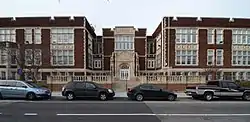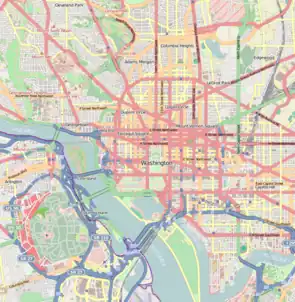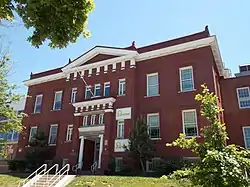Bruce-Monroe Elementary School at Park View
Bruce-Monroe Elementary School at Park View is a bilingual elementary school in Washington, D.C. Named after Blanche Bruce and James Monroe, it has been located in the historic Park View School in the city's Park View neighborhood since 2008. It is part of the District of Columbia Public Schools.
Park View School | |
 Park View School in 2013 | |
 | |
| Location | 3560 Warder Street, NW Washington, D.C. |
|---|---|
| Coordinates | 38°56′04″N 77°1′16″W |
| Built | 1916 |
| Architect | Snowden Ashford |
| Architectural style | Collegiate Gothic |
| NRHP reference No. | 13000213 [1] |
| Added to NRHP | May 1, 2013 |
Park View School
The building was designed by architect Snowden Ashford in 1916. It was listed on the District of Columbia Inventory of Historic Sites on May 24, 2012,[2] and added to the National Register of Historic Places on May 1, 2013.[3] The school continues to serve the community as an elementary school.
The origin of the school can be traced back to the efforts of the Park View Citizens' Association and their persistent appeal to Congress for funds to purchase the land and build a school for the white children in their growing neighborhood.[4] Ashford designed the school in his preferred style of Collegiate Gothic. Unusual for an elementary school, Ashford's design included a dedicated auditorium with a notable wooden truss that supports the auditorium roof.
Originally a 16-room structure, the school quickly became too small for the needs of the community. In 1920 the progressive platoon school model was adopted, unique in Washington, which helped address the school's space problem.[5] In 1929, 57 Park View students went on strike to protest the school district's attempt to shift enrollment to the Monroe School, in part because of the "gradual encroachment of the colored population on the Monroe School area."[6]
In 1931, two new wings were added to the building to again provide room for the growing enrollment.[7]
Blanche Kelso Bruce Elementary School

The Blanche K. Bruce School was an all-black school and community center during the Jim Crow era. In July 1898, the District of Columbia public school trustees ordered that a then new public school building on Marshall Street be named the Bruce School in his honor.[8] The Bruce School building was designed by architect William M. Poindexter in Renaissance Revival style of red brick with stone and pressed metal trim, with two floors of four rooms each. In 1927, a Colonial Revival style eight-room annex was constructed, designed by architect Albert L. Harris.[9]
Marshall Street later became Kenyon Street. The Bruce School building became the charter Caesar Chavez Prep Middle School in 2009, named for the Mexican-American labor organizer Cesar Chavez.[10] After the teachers unionized in 2017, the school was closed by the Chavez Schools in 2019.[11]
The building was designated a D.C. historic site on November 20, 2014, and added to the National Register of Historic Places on March 31, 2015.[9]
James Monroe Elementary School
Opened in 1889 as an all-white school, the James Monroe School was switched to an all-black school in 1931 as the neighborhood's racial makeup changed and white enrollment declined.[12] It was razed in 1971, with the exception of its auditorium, to make way for the integrated Bruce-Monroe Elementary School.[13][14][15]
Bruce-Monroe Elementary School
In 1969, Congress appropriated funds to construct the Bruce-Monroe school to replace the Bruce and Monroe Schools; construction began in 1971. In the fall of 1972, the Bruce-Monroe Elementary School opened on Georgia Avenue in Park View north of Howard University as an integrated school with an open-space classroom design.[12][14][16]
In 2008, the Bruce-Monroe Elementary School was relocated from Georgia Avenue to the Park View School campus. The former building, including the historic Monroe auditorium, was razed in 2009.[16] Following local activism to resist the construction of a parking lot, the school's former location became the Bruce Monroe Community Park and Garden in 2010.[17]
References
- "National Register Information System". National Register of Historic Places. National Park Service. March 13, 2009.
- It’s Official, HPRB Approves Park View School Designation as a D.C. Historic Site.Park View, D.C. blog.
- Park View School. National Register of Historic Places Program Web site, accessed June 2013.
- Park View Children Want New School. The Washington Times, August 31, 1913, p. 3.
- "Platoon School Solves Lack of Space Problem". The Washington Post. January 11, 1925. p. AU6.
- "Park View School Rebels Fight on After Reverse". The Washington Post. 1929-10-03. p. 1.
- Boese, Kent C., with Lauri Hafvenstein. Park View. Charleston, S.C.: Arcadia, 2011. p. 47.
- Annual Report of the Commissioners of the District of Columbia for the year ended June 30, 1899. Government Printing Office. 1899. p. 36.
- "Blanche Kelso Bruce School". DC Historic Sites.
- Lerner, Mark (2009-12-07). "Chavez-Bruce's new facility". Focus DC. The Washington Times.
- Abamu, Jenny (2019-01-24). "D.C.'s Only Unionized Charter School Faces An Abrupt Closure". WAMU.
- Boese, Kent (May 2013). "National Register of Historic Places Registration Form: Bruce School" (PDF).
- Boese, Kent C. (2011). Park View. Arcadia Publishing. ISBN 9780738582184.
- "District of Columbia appropriations for 1970 : hearings before the subcommittee of the Committee on Appropriations, House of Representatives, Ninety-first Congress, first session". Hathitrust. US G.P.O. 1969. p. 466.
- Boese, Kent (2009-09-29). "Then and Now: Monroe School auditorium". Greater Greater Washington.
- Labbé, Theola; Haynes, V. Dion (2008-01-13). "Schools Targeted For Closure". Washington Post.
- Giambrone, Andrew (2017-07-27). "How an Unofficial Park Became the Crucible in D.C.'s Long-Stalled Public Housing Reboot". Washington City Paper.

